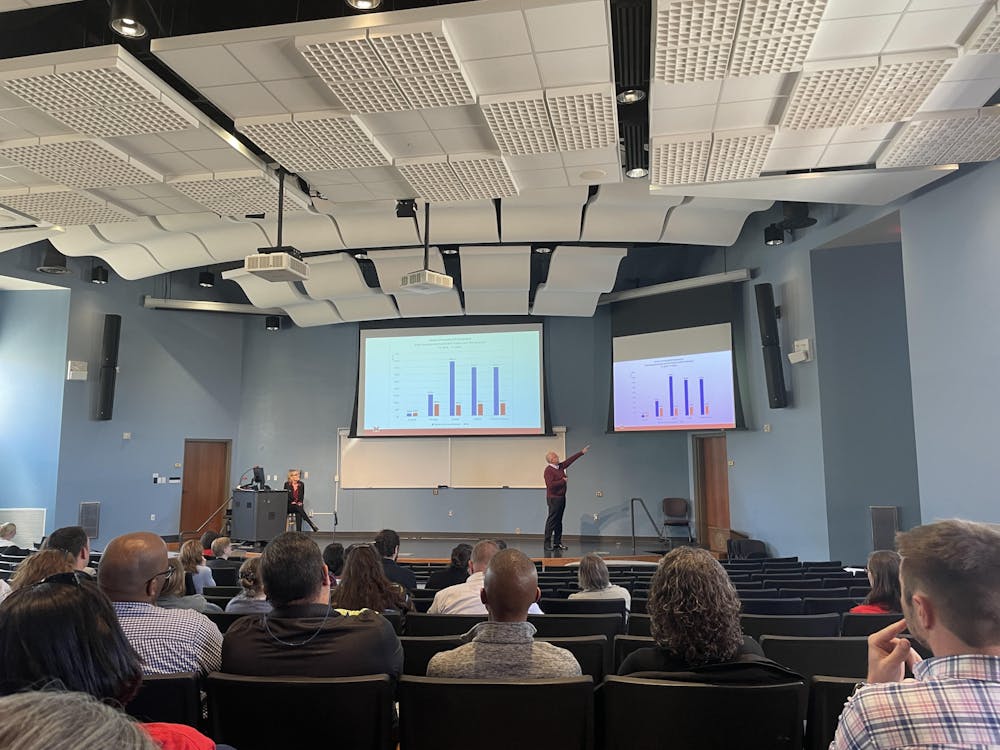After a $36 million budget deficit from last fiscal year, Miami University’s annual budget symposium brought news of a lower, but still existent, deficit.
“While Miami University’s overall financial performance last year was good, education and general spending exceeded its revenue by $10.3 million, and required a reduction in the reserves overseen by the Provost,” one of the presentation’s slides read.
The symposium, which took place on April 22, was led by university Provost Liz Mullenix and David Creamer, senior vice president for finance and business services and university treasurer. During the symposium, Mullenix and Creamer attributed the problem to a decline in tuition revenue.
In one graphic, Miami was compared to 100 other top doctoral-awarding institutions. Creamer said that among all the other institutions, Miami relied most heavily on tuition revenue for its funding.
“We’ve been up and down with state support,” Creamer said. “It’s why we’ve been so dependent upon tuition.”
In another chart, Creamer showed that as tuition increased yearly, the university should have earned an estimated $379 million in tuition revenue. However, when accounting for students’ financial aid and scholarships, the total comes to around $216 million.
“Tuition is rising, but we’re not capturing any of that,” Creamer said.
He added that financial aid and scholarships are necessary to continue attracting students considering they get into their primary picks for universities more often.
The university is trying to diversify its funds but is struggling to change amid the declining tuition. Creamer estimated that $14 million would be taken from the reserves to help the university. Mullenix reassured the crowd.
“We’re in a good position because we’ve planned for a rainy day,” she said.
Part of the reason Miami had a lower budget deficit for fiscal year 2024 was that vacant positions at the university lowered spending on salary and expenses. Creamer said this would not be a sustainable solution.
Part of the diversification of funds includes investing in new projects in hopes of seeing returns. In 2017-2018, income from investments only made up 1% of the budget, but they’re starting to pay off, making up 6% of the 2023-2024 budget. Creamer announced at the symposium that Miami had just committed to a new project, renovating Bachelor Hall, which would cost another $27 million.
Enjoy what you're reading?
Signup for our newsletter
One symposium attendee questioned why the university was making high-risk investments if the university was trying to avoid using reserves.
“If you look at what historically plays out, with what we have accumulated already, it’s a far better strategy for the university,” Creamer said.
As Miami saw its budget deficit at $36 million last year, Mullenix identified 18 majors as low-enrolled and required them to adjust. One faculty question at the symposium expressed concern about how these changes would impact the budget.
“The subtext here is that we are creating an experience to attract a certain type of student, or students and their parents, but I wonder what kind of faculty we’re going to be attracting with this model,” the professor said. “It seems to me that the university’s investing a lot in growing areas of the university for the faculty that are more expensive.”
“Where there is a higher salary, that’s what a business surcharge is for. So yes, faculty in business do have higher salaries typically, but we have a fee,” Mullenix responded. “So there is a front to help sort of offset the costs of those salaries.”
Creamer added that an increased number of students are coming to Miami with credit hours already completed. Most of those hours typically work toward fulfilling classes from some of those 18 low-enrolled programs.




